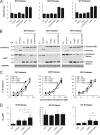Selection and Characterization of Rupintrivir-Resistant Norwalk Virus Replicon Cells In Vitro
- PMID: 29530860
- PMCID: PMC5923142
- DOI: 10.1128/AAC.00201-18
Selection and Characterization of Rupintrivir-Resistant Norwalk Virus Replicon Cells In Vitro
Abstract
Human norovirus (HuNoV) is a major cause of nonbacterial gastroenteritis worldwide, yet despite its impact on society, vaccines and antivirals are currently lacking. A HuNoV replicon system has been widely applied to the evaluation of antiviral compounds and has thus accelerated the process of drug discovery against HuNoV infection. Rupintrivir, an irreversible inhibitor of the human rhinovirus 3C protease, has been reported to inhibit the replication of the Norwalk virus replicon via the inhibition of the norovirus protease. Here we report, for the first time, the generation of rupintrivir-resistant human Norwalk virus replicon cells in vitro Sequence analysis revealed that these replicon cells contained amino acid substitutions of alanine 105 to valine (A105V) and isoleucine 109 to valine (I109V) in the viral protease NS6. The application of a cell-based fluorescence resonance energy transfer (FRET) assay for protease activity demonstrated that these substitutions were involved in the enhanced resistance to rupintrivir. Furthermore, we validated the effect of these mutations using reverse genetics in murine norovirus (MNV), demonstrating that a recombinant MNV strain with a single I109V substitution in the protease also showed reduced susceptibility to rupintrivir. In summary, using a combination of different approaches, we have demonstrated that, under the correct conditions, mutations in the norovirus protease that lead to the generation of resistant mutants can rapidly occur.
Keywords: antiviral agents; drug resistance mechanisms; noroviruses; protease inhibitors; proteases.
Copyright © 2018 Kitano et al.
Figures






Similar articles
-
The enterovirus protease inhibitor rupintrivir exerts cross-genotypic anti-norovirus activity and clears cells from the norovirus replicon.Antimicrob Agents Chemother. 2014 Aug;58(8):4675-81. doi: 10.1128/AAC.02546-13. Epub 2014 Jun 2. Antimicrob Agents Chemother. 2014. PMID: 24890597 Free PMC article.
-
In vitro resistance study of rupintrivir, a novel inhibitor of human rhinovirus 3C protease.Antimicrob Agents Chemother. 2007 Dec;51(12):4366-73. doi: 10.1128/AAC.00905-07. Epub 2007 Oct 1. Antimicrob Agents Chemother. 2007. PMID: 17908951 Free PMC article.
-
A Novel Class of Norovirus Inhibitors Targeting the Viral Protease with Potent Antiviral Activity In Vitro and In Vivo.Viruses. 2021 Sep 16;13(9):1852. doi: 10.3390/v13091852. Viruses. 2021. PMID: 34578432 Free PMC article.
-
Proteases of human rhinovirus: role in infection.Methods Mol Biol. 2015;1221:129-41. doi: 10.1007/978-1-4939-1571-2_10. Methods Mol Biol. 2015. PMID: 25261311 Review.
-
Current tools for norovirus drug discovery.Expert Opin Drug Discov. 2016 Jun;11(6):529-41. doi: 10.1080/17460441.2016.1178231. Epub 2016 May 2. Expert Opin Drug Discov. 2016. PMID: 27108716 Free PMC article. Review.
Cited by
-
A new antiviral scaffold for human norovirus identified with computer-aided approaches on the viral polymerase.Sci Rep. 2019 Dec 5;9(1):18413. doi: 10.1038/s41598-019-54903-7. Sci Rep. 2019. PMID: 31804593 Free PMC article.
-
Design, development, and validation of a strand-specific RT-qPCR assay for GI and GII human Noroviruses.Wellcome Open Res. 2021 Sep 23;6:245. doi: 10.12688/wellcomeopenres.17078.1. eCollection 2021. Wellcome Open Res. 2021. PMID: 34708158 Free PMC article.
-
The Adenosine Analogue NITD008 has Potent Antiviral Activity against Human and Animal Caliciviruses.Viruses. 2019 May 30;11(6):496. doi: 10.3390/v11060496. Viruses. 2019. PMID: 31151251 Free PMC article.
-
Viral Interference as a Factor of False-Negative in the Infectious Adenovirus Detection Using Integrated Cell Culture-PCR with a BGM Cell Line.Food Environ Virol. 2021 Mar;13(1):84-92. doi: 10.1007/s12560-020-09453-x. Epub 2021 Jan 4. Food Environ Virol. 2021. PMID: 33392927
-
Noroviruses subvert the core stress granule component G3BP1 to promote viral VPg-dependent translation.Elife. 2019 Aug 12;8:e46681. doi: 10.7554/eLife.46681. Elife. 2019. PMID: 31403400 Free PMC article.
References
Publication types
MeSH terms
Substances
Grants and funding
LinkOut - more resources
Full Text Sources
Other Literature Sources

